SOME FURTHER CONSIDERATIONS:
A CLOSER LOOK
STARTING WITH SOME REVIEW:
Two engravings exist of the Unitarian Congregational Church of the Messiah.
In May 1839, this church was completed several blocks behind the University of the City of New York on the corner of Waverley Place and Broadway (see 1854 plat map below). Both engravings show a castellated top rising just above circular church windows on each side of a tower.


A quarter plate daguerreotype exists in the John William Draper Collection at the Smithsonian Institution. It records a view (circa early 1850s) of the same Unitarian Church. Slight variations in the castellation, etc., from the engravings can probably be ascribed to artistic license by the engravers. The original reversed image from the Draper Collection is shown below on the left and is laterally corrected on the right.

It would be challenging to find another structure existing in September or October 1839, of the same approximate height that was also castellated just above dark circular windows. Until record of another such building is found, the Unitarian Church of the Messiah on Broadway could logically be presumed to be virtually unique in New York City (or elsewhere).
The three extant images above
will be used to further consider the tower visible in plate "H".

Both plate "H" and the daguerreotype in the Draper Collection at the Smithsonian show similar proportions of the church tower from the same relative distance. Both images were likely taken from the University of the City of New York.

The Smithsonian daguerreotype at right in the above comparison, was apparently taken from the chapel window in the center of the University building (as was the first daguerreotype that Draper took in September 1839). The almost front-on view of the church from this position clearly recorded one central dark circular window and the exact spaces between the actual (not artist-engraved) castellation on the top of the west face of the tower.
Shown at center in the above comparison, the tower in plate "H" shows a shifted angle with the camera likely aimed down Waverly Place. It captures the northwest corner/edge of the Unitarian Church instead of the west face of the church shown in the Smithsonian daguerreotype.
Plate "H" records something of the TWO dark windows on both the north and west sides of the church tower. The University building covered the entire width of a block, so the shift from the center window to Waverly Place would have been even more substantial than the angle shown in the engraving on the left of the above comparison.
Since an edge rather than the side of the church tower was facing the camera in Plate "H", the castellation at top is seen at an angle. Efforts to count or otherwise distinguish specific details in the castellation of the tower in plate "H" would probably be futile (any spaces on the north or west side would be visually "filled" with castellation from the back side of the tower).
Plate "H" was apparently composed to center the Unitarian church.
Vines and vegetation hanging in the greenhouse/garden screened row houses along the north side of Waverley Place out of the picture.
The northwest corner/edge of the University building itself screened off some of the row houses built along the south side of Waverly Place, which were set back from the street and built some distance BEHIND the north side of the University (clearly shown below in an 1837 engraving at left and an 1850 engraving at right).
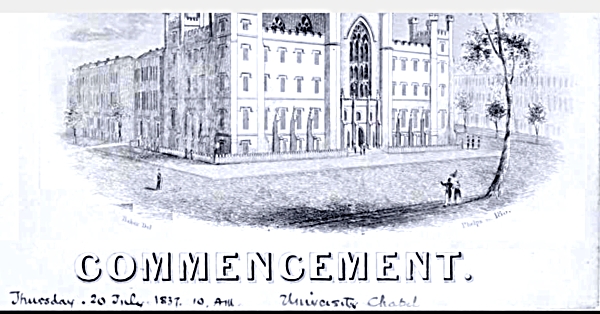
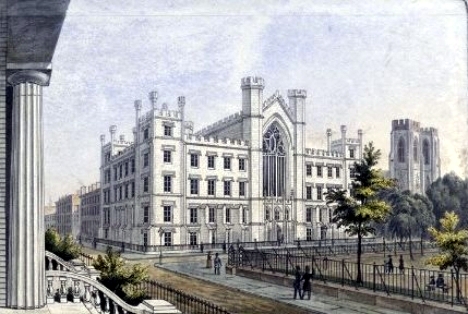
WASHINGTON SQUARE PARK
Exactly where might the camera and subject have been located in order for plate "H" to have recorded a view of the Unitarian Church tower by pointing the camera eastward down Waverly Place?
There does not appear to be easily discernible evidence in the plate "H" daguerreotype itself as to the exact distance between the sitting subject and the structure behind him. Also, no historical evidence yet located records any type of greenhouse/garden located up close against the edge of the University building.

A case can be made that the subject in plate "H" was sitting some distance to the west of the University building. The west side of the University fronted on Washington Square Park. Locating plants, pots, a trellis, etc., in the area approaching the Park would have been more logical than placing them right up against the University building itself.
An attempt is made below to guess at the relative distance in question by using the same (circa 1880) photograph of the front of the University building shown previously. This photograph is perhaps the best extant image with a similar (though not exact) perspective to the perspective shown in plate "H".
A small copy of the 1839 daguerreotype is superimposed on the later photograph to make the structure behind the sitter appear to be relatively the same size in both images. Hopefully, this will allow the viewer to perceive how the subject in the 1839 daguerreotype might have been posed in a greenhouse/garden located closer to Washington Square Park, and thus well in front of the northwest edge of the University building:

Road and path surfaces reflect brightly in the circa 1880 view of the University. The brighter area directly beneath the flower pot stand in plate "H" perhaps recorded the more reflective surface of Waverly Place or of "University Place", which ran between the University building and Washington Square Park.
POINTING THE CAMERA DOWN WAVERLY PLACE:
If plate "H" was taken from some distance in front rather than right up close against the University building, it would have been relatively simple to choose the best angle in which to aim the camera eastward down Waverly Place in order to center the Unitarian Church tower in the daguerreotype.
It is important to realize that the top part of the Unitarian Church "towered" well above all other surrounding buildings including those built along the south side of Waverly Place. The tower looms way above the upper story of the rear of Waverly Place buildings in the daguerreotype of the Unitarian Church that is located in the Draper Collection at the Smithsonian.

(The original reversed image is shown on the left
and is laterally corrected on the right.)
Greatly enlarged detail of the tower area in laterally corrected plate "H" is show below with both positive and negative surface reflection. The castellated tower rises similarly above other indefinable structures directly beneath it and extending over to the building behind the sitter. These indefinable structures below the tower in plate "H" are likely buildings that stood along Broadway and/or the south side of Waverly Place.
In the "positive" reflection of the plate detail below,
the tower and structures beneath the tower appear as lighter.
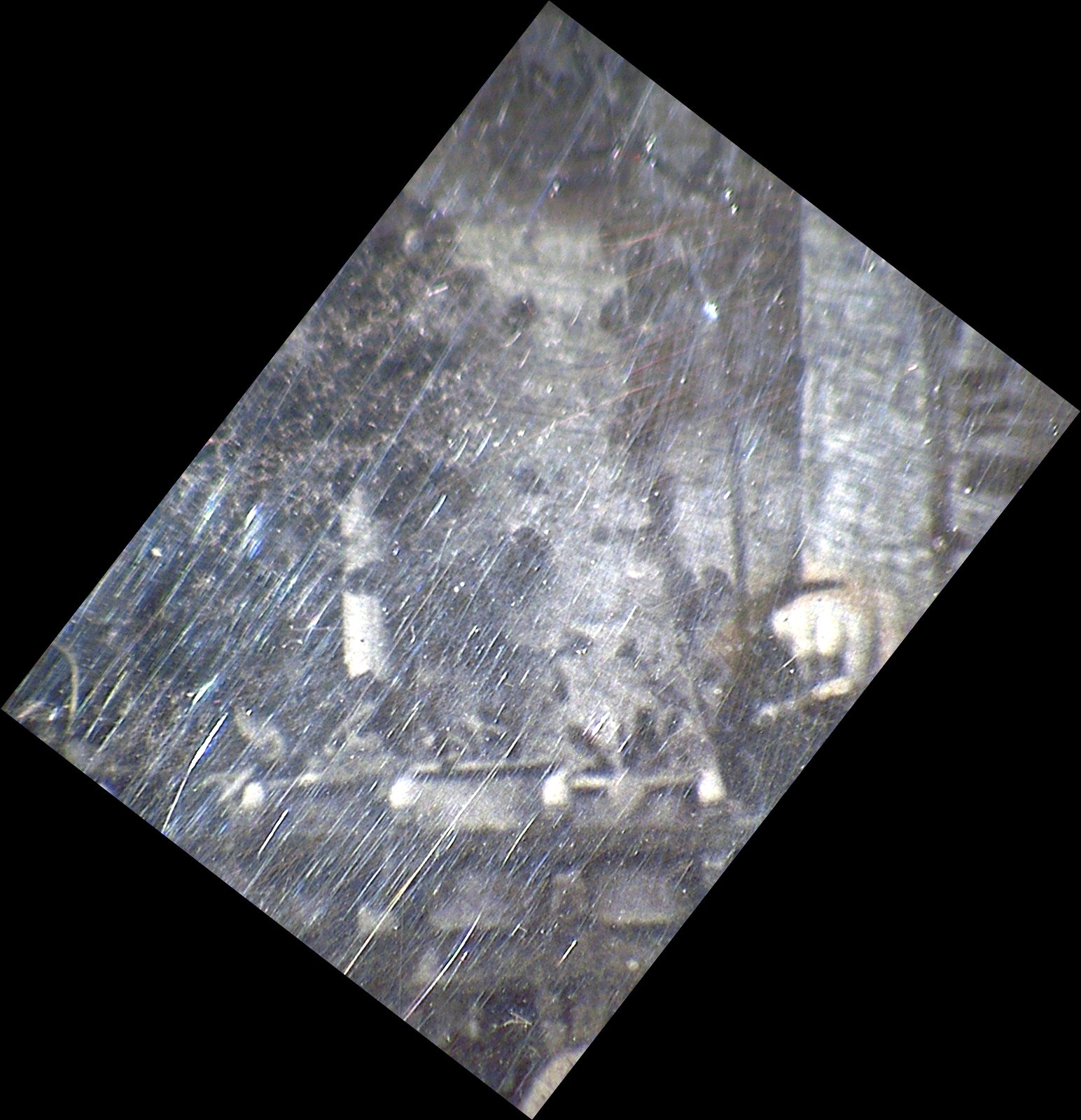
In the "negative" reflection below,
the tower and same structures beneath the tower show up as dark.
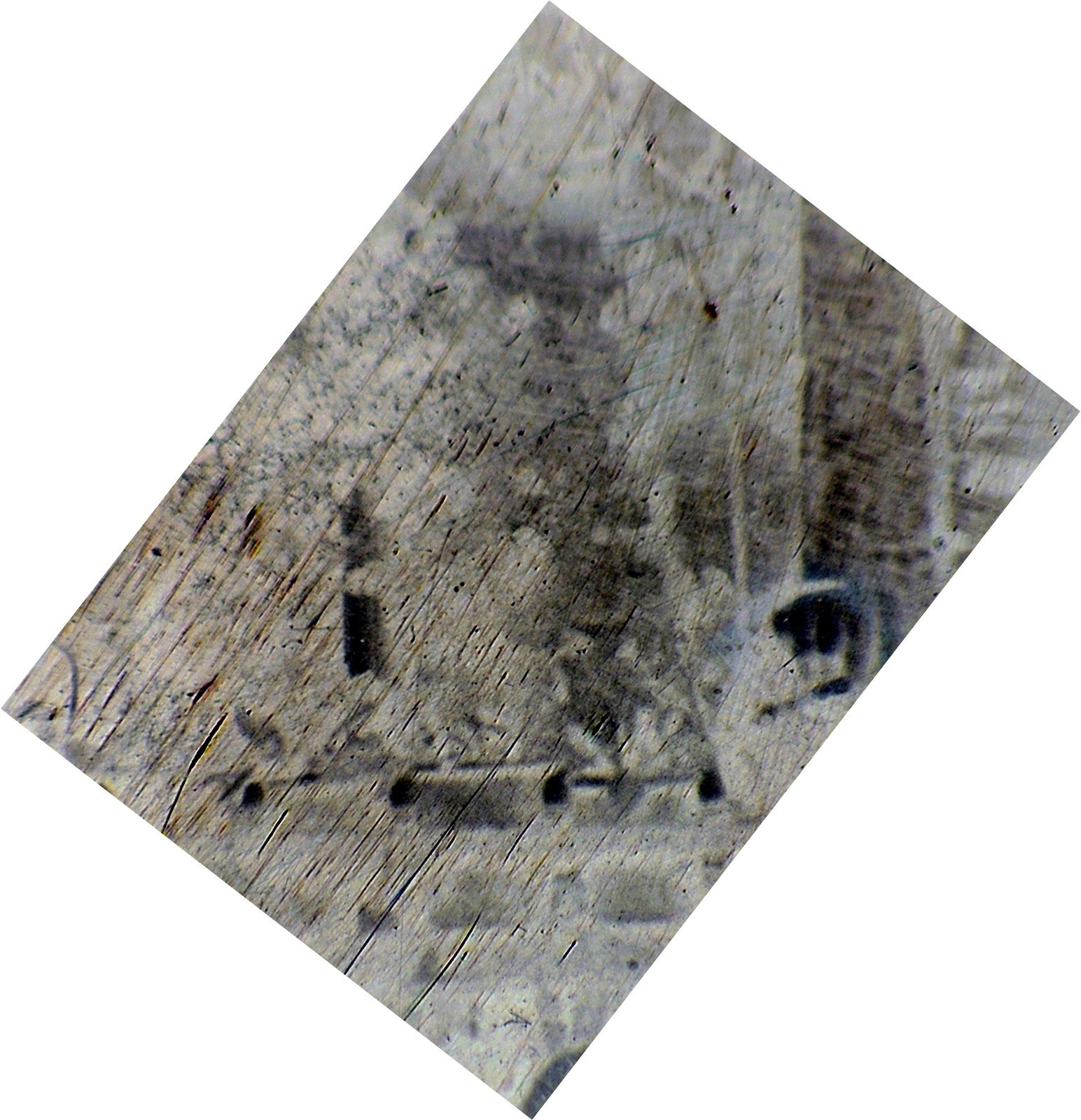
THE WROUGHT IRON FENCE
Another question arises.
If the building behind the sitting subject in plate "H" is the northwest edge of the University, where is the wrought iron fence that surrounded the University building? A fence is clearly shown in prints and engravings of the early period and is still visible in the circa 1880 photograph.
Looking once more at the photograph of plate "H" superimposed on the later photograph of the front of the University building (shown with enlarged detail below), several observations could be made concerning a fence.



First, if the subject in plate "H" was sitting well in front of the edge of the University building, then the circa 1880 photograph indicates that the wrought iron fence would be recorded in the 1839 daguerreotype as quite small and relatively indistinct.
Second, comparing both photographs, the fence would apparently be located in the daguerreotype at the exact level that is mostly blocked from view by the sitter's crossed legs and the bottom of his chair. In plate "H", the only area that actually could have recorded the fence would have been the extreme right edge of the laterally corrected image.
Even using a stop, spherical aberration in early camera lenses could render the outer edge of daguerreotypes rather indistinct. Nevertheless there is "something" showing at just the right place in plate "H" to conceivably be evidence of a distant & indistinct wrought iron fence.
Looking carefully at enlarged detail of laterally corrected plate "H" (shown below with both positive and negative surface reflection), permits a close examination of the relevant section of the right edge of the image.

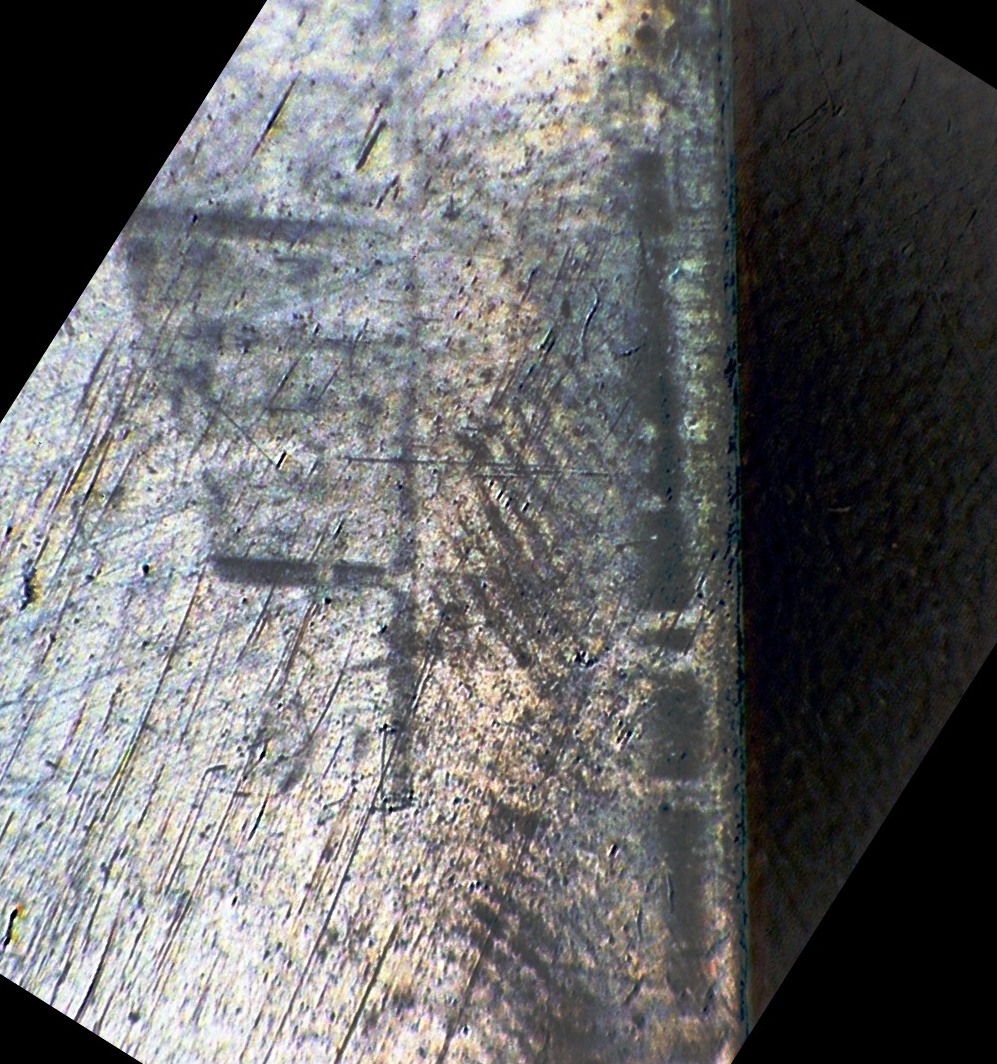
Part of a trellis(?) is clearly visible just behind the chair of the sitter (the chair is not shown in this image detail). The lower part of the trellis is close enough to the chair to be in quite clear focus. Even the heads of screws/nails holding the slats of the trellis together appear to be visible (see above).
Just beneath the second horizontal slat up from the bottom leg of the trellis is an area with one or two indistinct horizontal lines that are not part of the trellis. It is quite difficult to get a good picture of this area of plate "H" with the equipment available, but the line or lines are definitely part of the original daguerreotype exposure and not flaws or abrasions on the plate. No other horizontal lines are seen between other slats of the trellis.
Though certainly open to subjective interpretation, a case could be made that the line/lines conceivably could represent fragmentary visual evidence of a distant, indistinct, wrought iron fence.
Once again, the composite photographs below are instructive.



The exposed area between the two lowest trellis slats is certainly indistinct. However, it is rather interesting that when one examines plate "H" exactly where a fence might be located, one finds something that could conceivably represent the distant wrought iron fence.













